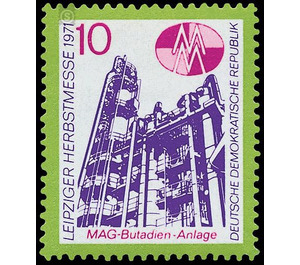Leipzig Autumn Fair - Germany / German Democratic Republic 1971 - 10 Pfennig
Theme: Economy & Industry
| Country | Germany / German Democratic Republic |
| Issue Date | 1971 |
| Face Value | 10.00 |
| Color | green violet |
| Perforation | K 13 1/2: 13 |
| Printing Type | offset |
| Stamp Type | Postage stamp |
| Item Type | Stamp |
| Chronological Issue Number | 1442 |
| Chronological Chapter | GER-DDR |
| SID | 357012 |
| In 22 Wishlists | |
Leipziger Herbstmesse 1971 At the Leipzig Autumn Fair in 1971, the Ministry of Posts and Telecommunications of the German Democratic Republic issues two special postage stamps with illustrations of chemical plants produced in the GDR. Chemical plants from the German Democratic Republic In the production program of the chemical plant construction of the GDR are u.a. Reforming plants and Butadiengewinnungsanlagen included. These plants produce on the basis of modern chemical-technological processes, which were developed in socialist community work between the chemistry and the chemical plant construction of the GDR. With the scientific-technical and economic performance indices of these chemical plants, the world's top is determined in such types of plants. Within the chemical plant construction, a meaningful specialization takes place, e.g. VEB SKL Magdeburg responsible for the research and development, design, construction, technology, production, installation and commissioning of reforming plants, the VEB Maschinen- und Apparatebau Grimma - Chemieanlagenbaukombinat - for butadiene recovery plants. 10 Pfennig value MAG butadiene plant The butadiene production plants offered by VEB Maschinen- und Apparatebau Grimma work according to the "Difex process" of the VEB Leuna-Werke "Walter Ulbricht". This process is based on extractive distillation with the selective solvent dimetylformide (DMF) and ensures the isolation of an inexpensive butadiene. The butadiene produced by the process described below meets all requirements that are placed on the coveted starting material for the known chemical syntheses. In particular, the production of very high-grade rubber types is possible by the stereospecific polymerization. A depleted of sulfur compounds C4 fraction enters the first section of the plant and is charged in an absorber with solvent. Butenes are separated here and removed from the plant. In the Desorberteil the system, the solvent is degassed and gets back into the circulation. In the redistillation part of the plant passes a crude butadiene, which is freed in a column of C3 and C5 hydrocarbons. The subsequent Butadienwäsche serves for fine cleaning of the final product. If butadiene should be stored before further processing, stabilizer solution must be added to the product. The solvent regeneration takes place continuously in a side stream. Product description Feedstock: C4-hydrocarbon fraction Content of C4-hydrocarbons about 94 percent Butadiene content minimum 25 percent End product: butadiene 1.3 at least 99.5 percent Acetylene content maximum 0.01 percent By-product: A by-product is a butene fraction. The extraction process for the isolation of butadiene, as implemented in the Difex process, has great flexibility and economy. It can process very different composition C4 fractions, without previously a constant butadiene concentration must be achieved by mixing. By using a selected BMSR technique, the process can be performed largely automatically.


